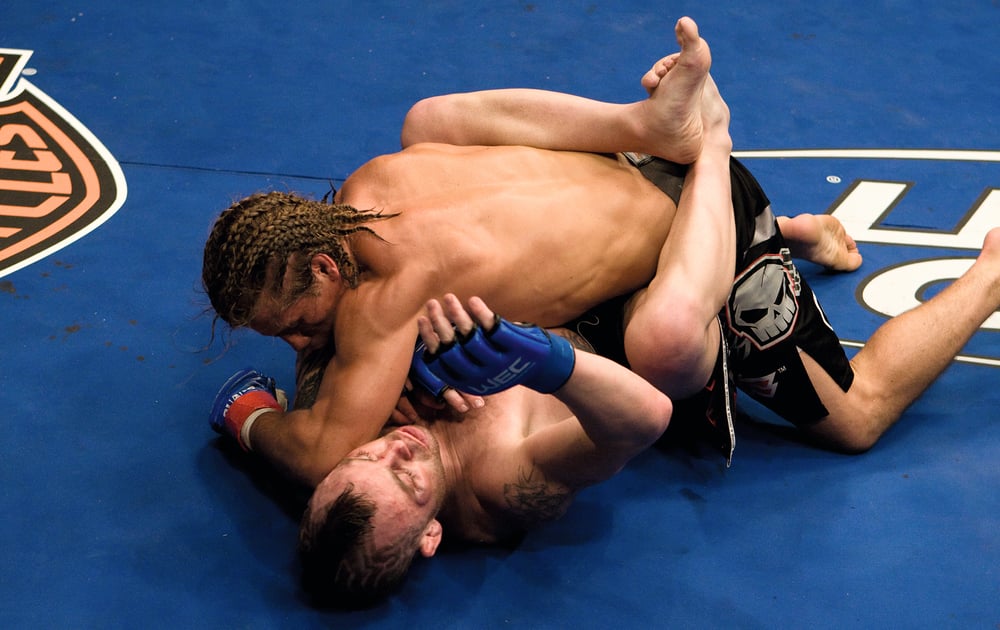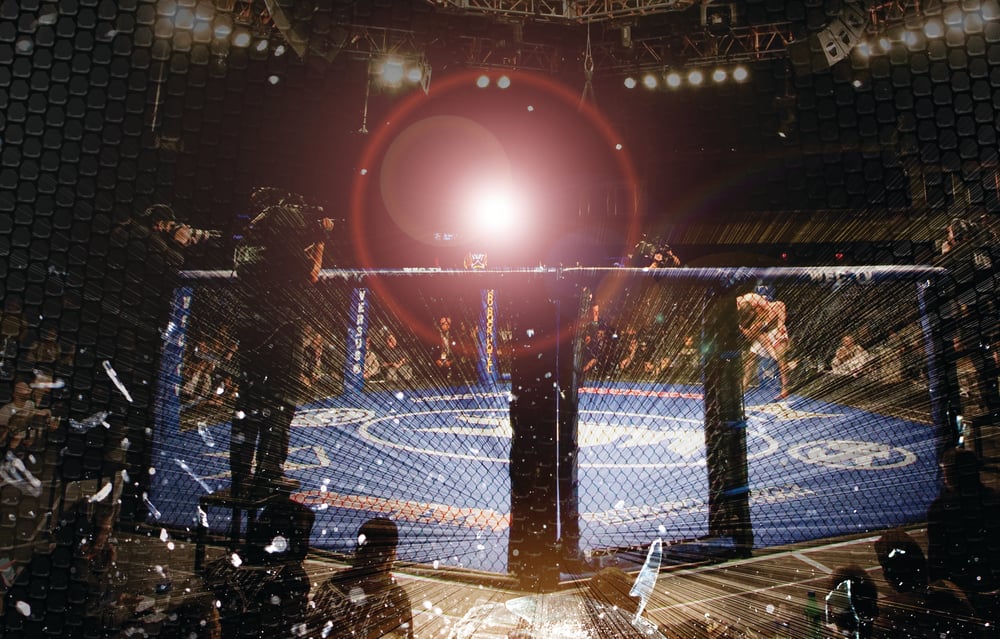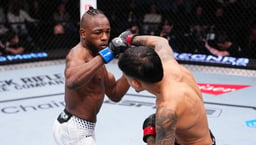
Issue 135
December 2015
Five years after the WEC cage door closed for the final time Fighters Only celebrates the legacy of the most action-packed promotion in MMA history
The initials WEC will always have a special place in the hearts of die-hard MMA fans. Though its fighters didn’t have the benefit of the bright lights of the UFC, they made their names by letting it all hang out and putting on some of the sport’s greatest ever fights. They captured the true essence of mixed martial arts. As we approach the fifth anniversary of its swansong event in December 2010, FO looks back at the legacy of the beloved blue cage.
EARLY DAYS
Long before World Extreme Cagefighting became the proving ground for the planet’s premier lighter-weight fighters, it began life as regional promotion in the heart of California’s Central Valley. But founders Reed Harris and Scott Adams faced a major problem before it began, as back in 2000 the sport was illegal in The Golden State.
The solution? Promote the show on Native American land. Yet even with friends in Lemoore’s Tachi Palace Hotel and Casino, they faced a battle to get their idea off the ground.
“One of the first problems we had was that the Tachi tribe was divided about MMA and many tribal members were under the impression the sport was too violent,” recalls Harris. “It took us over a year and six or seven meetings to convince them to let us do one show and demonstrate that the fans would come.”
And come they did. WEC 1: Princes of Pain – headlined by UFC legend Dan Severn vs. MMA journeyman Travis Fulton in June 2001 – was a sell-out. The promotion was off and running and found further success in the following years with action-packed cards full of prospects, local stars and the occasional huge name – including former UFC champion Frank Shamrock, who came out of retirement to star in the main event of WEC 6.
With backing from the fans and a venue to call home, WEC had taken off and was on its way to becoming one of the top regional shows in the United States.
THE ZUFFA EFFECT
As well as securing the support of local fans, Adams’ and Harris’ fledgling brand captured interest from some major players in Las Vegas, Nevada. “We had a good relationship with (UFC president) Dana White and he was very supportive of us,” says Harris. “I knew this was important to the long-term success of our promotion.”
Sure enough, WEC became known as one of the best places to see the UFC stars of the future. Countless fighters made their mark in the blue cage before moving on to the sport’s biggest stage, including Chris Leben, Mike Swick, Nick and Nate Diaz, Shane Carwin, Brian Stann and Glover Teixeira.
Harris adds: “We always wanted our fighters to end up in the UFC. That was good for our brand. We were headed in the right direction and believed we could be a testing ground for future UFC fighters. We were the minor leagues and happy to be in a good place.”
Some stars moved on, but there was always new blood to create excitement. Impressed by what they saw, bosses at UFC’s parent company, Zuffa, bought the brand in December 2006. In January of the following year, it was moved to Vegas and by June 2007, it had a home and the chance to reach more eyeballs than ever before on cable TV. This was a new and improved WEC.

THE BIG TIME
WEC 25 was the first event to be broadcast on the Versus network and it was headlined by the man who would become the face of the company – 145lb champion Urijah Faber. It was all part of a new shift towards a focus on fighters in the lighter weight classes, particularly 135lb and 145lb, which at the time were not promoted by the UFC.
Though Harris wasn’t on board with the idea initially, he soon saw the benefits. “At first I wasn’t that excited,” he says. “Dana felt that in order to set WEC apart, we needed to do something different. It ended up defining the organization and helped us make our mark.”
No mark was bigger than the one made by WEC 34. One year after the first Versus show, this landmark event drew a record 1,540,000 viewers to witness Faber defend his featherweight title against UFC legend Jens Pulver in a five-round barnburner.
This new direction was beginning to pay off, so the UFC absorbed the WEC light heavyweight, middleweight and welterweight divisions, leaving new matchmaker Sean Shelby – now a UFC matchmaker – with just three divisions to organize. But he had faith their fighters could carry the company.
“I had an awesome and huge responsibility,” says Shelby. “Find the best talent in the world. Make the best fights in the world. It’s really just about bringing the most talented contenders to challenge the champion. I knew everything else would just fall into place.”
Shelby’s stewardship led to WEC’s two best years thanks to fun fights between world-class athletes from top to bottom of every fight card. This was seldom more evident than at WEC 48, the first and only pay-per-view event in the promotion’s history. Its strongest line-up of fighters was assembled – including a headline match between José Aldo and Urijah Faber – and they delivered some incredible action. WEC had cemented its place as the number-two MMA organization in the world and the place for fans to see the most exciting fighters.

END OF AN ERA
In 2010, as the UFC needed more talent to fill its fight cards, it accelerated its expansion around the globe. Rumors of a merger with its little cousin had circulated for some time, and in October, White announced that all WEC fighters would be absorbed onto the roster of the world’s premier fighting organization. The athletes deserved the increased exposure and many people suggested their frenetic fighting would actually help to make a stronger product.
One question remained, how would WEC lightweights fare when they tested in the Octagon? Many thought the UFC elite would be too much for them, but the top guys were determined to prove their worth and passed with flying colors. Benson Henderson and Anthony Pettis became champions in the Octagon, and Donald Cerrone is scheduled to fight for the title in December. At 170lb, Johny Hendricks and Carlos Condit represented WEC as they won full and interim belts respectively.
Shelby recalls: “I remember spirited conversations with pundits about how WEC fighters would stack up versus other fighters in everyone’s top 10 lists. Two 155lb UFC champions later, you have to look back and say not only were they putting on some of the best fights in the sport, but these guys were actually underrated.
“Henderson, Pettis, and Cerrone drove the point home. To this day, WEC alumni still acknowledge an ‘us versus the world’ mentality with comments or a fist-bump backstage at UFC events.”
Unlike so many other defunct American promotions of the past, WEC had a happy ending. The staff and fighters found a new home and left a legacy that Harris – now VP of athlete development at the UFC – remembers with pride. “We had some of the greatest fighters and a place where the lighter weight guys could have a chance to show the world how good they are,” he adds.
“Also, look at the fighters that came with us into the UFC. They have also made their mark. I remain very proud of all our fighters. We also had a great staff who all work for the UFC today. I’m grateful for what we did.”
Carlos Condit
The last WEC welterweight champion
“Fighting in the WEC was a really special time in my life and career. It had great opponents and great production value. What was really cool, as a young guy, was getting the opportunity to display my skills for Dana White and Lorenzo Fertitta – that was motivation. I was pumped to get out there.
“When I fought John Alessio for the title at WEC 26 I was a young kid, coming out of a somewhat no-name gym. He had been in the UFC and was fighting out of Randy Couture’s gym, training among all these stars of the sport. Nobody was giving me much chance in the fight, but I went out there and just destroyed him, and choked him out in the second round.”
Dominick Cruz
The last WEC bantamweight champion
“One of my favorite memories is beating up Scott Jorgensen for five rounds and getting two belts strapped around me. I retired the WEC belt and I was the first ever UFC 135lb champion. I got to wear two belts, fight somebody for it and make a bunch of money doing it. It was an amazing feeling.
“Also, getting to meet all those guys in the WEC was great, because there were a lot of questions when the WEC was around, like how we’d fare in the UFC? Half the WEC champions were champions in the UFC. That tells you that we’ve always been the highest-level guys in the world.
“We were as good as them then. It was a great promotion that helped us all get a kick-start in the lighter divisions.”
Sean Shelby
The UFC matchmaker’s four fighters who best personified the WEC fighting spirit
Urijah Faber
“The face of the rise of the lighter weight divisions and simply an amazing bearer of the torch.”
Donald Cerrone
“Any time, any place. I remember ‘Cowboy’ getting into the van, sliding over next to me an hour after his epic five-round fight of the year with Benson Henderson. He looks at me and said, ‘What’s next? I need a fight!’”
Dominick Cruz
“The man with a giant chip on his shoulder. Never stopping. Never relenting. Always out to prove you wrong.”
Anthony Pettis
“Showing the world what the lighter weights could do that bigger guys just can’t. He’s a human highlight reel, Jackie Chan and a ninja all rolled into one.”
...









